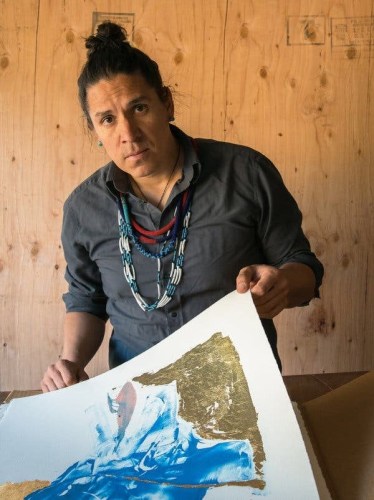
Mr. Galanin at his studio in Sitka, Alaska .Credit: Ben Huff for The New York Times
The Whitney Biennial Called. How Will They Answer?
By Siddhartha Mitter
May 9, 2019
Nicholas Galanin
“All these institutions come with politics.”
Nicholas Galanin stepped outside his house on the hill and aimed his phone camera toward the bay. An artist of Tlingit descent, he lives in Sitka, Alaska, making a video visit more convenient.
“There’s a herring fishery here, managed by the state,” Mr. Galanin, 39, said. He explained how overfishing had depleted the stock despite years of warnings by elders. Native knowledge was overlooked in arts as well, he said. Ethnography presented it as static, when in fact it adapts.
Mr. Galanin is a craftsman who recently led the carving of a 40-foot totem pole near Juneau. He is also adept at contemporary techniques like video and installation.
His work will greet Biennial visitors in the form of a large ink and gold-leaf monoprint of a female shaman in the museum lobby. A textile piece, combining imagery of a prayer rug and a television screen flickering white fuzz, is also in the show.
By refusing to stay bounded, Mr. Galanin said he could connect with other artists and communities, and help Native culture evolve on its own terms. “People who want to fetishize us are going to have to wait and see what we do next,” he said.
Mr. Galanin is a veteran of museum shows, including a midcareer retrospective at the Heard Museum in Phoenix. He welcomed the Biennial curators’ decision to feature several Native artists. “It’s empowering to have voice in these spaces,” he said.
Still, he tempered his expectations of dramatic change. “All these institutions come with politics,” he said.